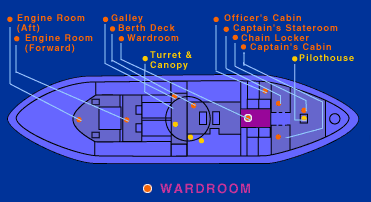 |

|

|
 |
|
Intro |
Galley |
Deck |
Canopy |
Wardroom |
Officer's Cabin |
Captain's Cabin |
Captain's Stateroom |
Turret |
Pilothouse |
Chain Locker |
Berth Deck |
Engine Room - Forward |
Engine Room - Aft Wardroom A wooden bulkhead with a door in the center separated the wardroom and officers quarters from the berth deck. Two portholes on either side of the door offered the officers a view into the berth deck, allowing them to keep an eye on the crew. Small-arms racks mounted on the wardroom bulkhead held muskets, revolvers, and cutlasses, which were issued to crew members assigned to landing parties or as needed to repel boarders. Two small rooms just inside the bulkhead to port and starboard served as the Monitor's dispensary and spirit locker, while the rest of the 9-by-15-foot compartment was the wardroom proper. Here the Monitor's officers took their meals and gathered in the evenings to socialize or entertain visitors. Furnishings included an oak table, hardwood chairs, lanterns, and shelves, all for the comfort of the officers. Monitor inventor John Ericsson realized the transition from traditional warships to a semi-submerged ironclad would not be easy for naval officers, so he strove to make the Monitor as comfortable as possible for them. At his (and his investors') expense, Ericsson lavishly furnished the officers' living areas with some of the best non-traditional materials he could gather in New York. He had the walls whitewashed and trimmed with fine walnut and oak moldings, and he had the floor covered with a canvas oilcloth with a thick tapestry carpet laid on top. Overhead, two deck lights allowed small shafts of sunlight and, when opened on pleasant days, air to penetrate the area. Ericsson also provided white ironstone china for the table settings. Each piece bore the name Monitor in gold gilt, and one account alludes to monogrammed silver. Blowers in the vessel's stern ventilated both the berth deck and the wardroom. Air from the blowers reached the crew areas through the flooring. Ericsson had the floor beams forward of the midships bulkhead perforated on the outboard ends to allow air to pass through and up into the berth deck and wardroom. Registers fitted into the floor controlled the volume of air fed into the various living areas, while a radiator heated by the ship's boilers warmed the area in cold weather. Tour the Monitor | Behind the Scenes Eyewitness to the Battle | Steam Machine | Resources Transcript | Site Map | Lincoln's Secret Weapon Home Previous Sites | Adventures | Join Us/E-mail | TV/Web Schedule Teachers | Site Map | Search | Shop | To print PBS Online | NOVA Online | WGBH © | Updated October 2000 |
||